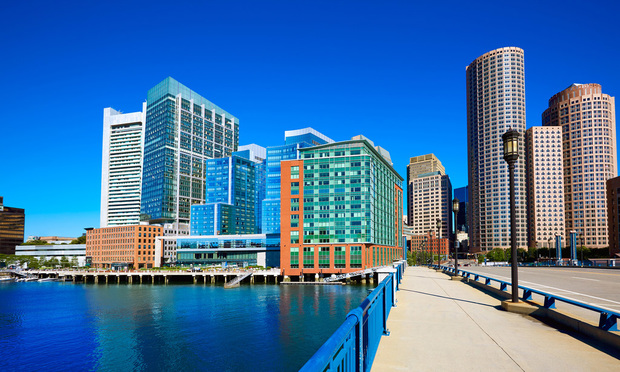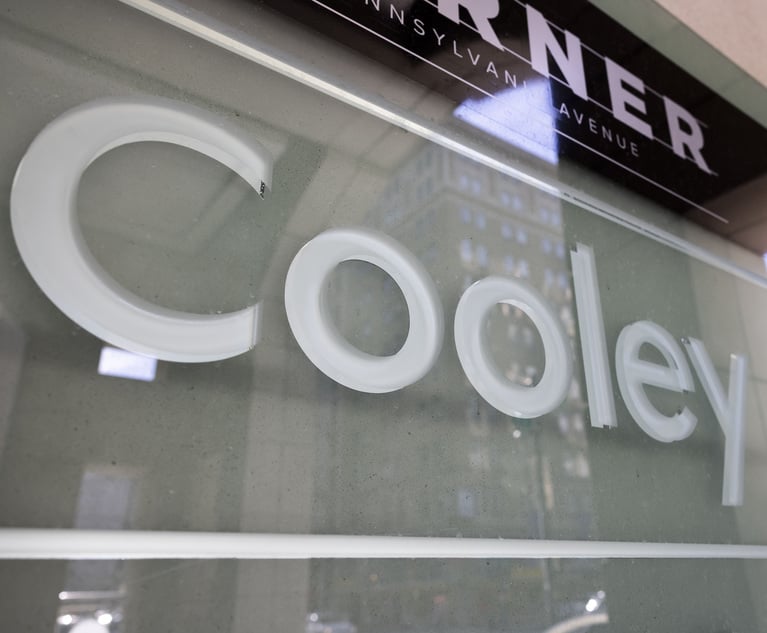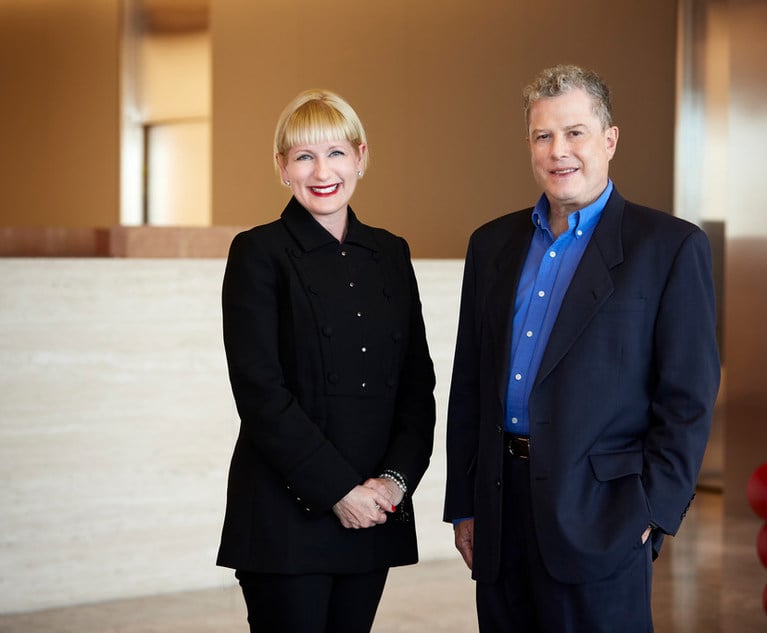How Boston Became a Beacon on the Hill to Big Law
As Boston undergoes a renaissance, law firms are being drawn to its shores, ready to capitalize on a booming market.
March 30, 2018 at 04:00 PM
8 minute read
 The Boston skyline from the Seaport Boulevard bridge.
The Boston skyline from the Seaport Boulevard bridge.
Two hundred years ago, the area now known as the Seaport District in South Boston was a muddy mess. In fact, until the 1800s, most of it was underwater.
The neighborhood has lived many lives in the interim, transitioning over the 20th century from a bustling shipping harbor to a desolate haven for abandoned warehouses. Over the past decade, it's been reinvented once more, experiencing its own renaissance in line with the changes taking place across industries in Boston.
What was a heavy manufacturing town just 40 years ago is now a destination for entrepreneurs looking to capitalize on the city's burgeoning health care, biotechnology, life sciences and technology sectors. Boston's financial sector has also blossomed, and its private equity sector is one of the strongest in the nation. All that growth has, in turn, created a booming market for legal services.
“The current legal market in Boston is a lot like the recently revamped Seaport District—hot, bustling with activity and constantly changing,” says Mary Rosenfeld D'Eramo, vice president of operations at attorney placement firm Mestel & Co.
While the Boston legal market traditionally has been dominated by law firms with roots in the city on a hill, this new market for legal services has served as a siren call to out-of-town Big Law firms looking to capture the legal work and talent emanating from the newfound growth.
“Boston is home to several practice areas with the highest demand, which distinguishes the market and makes it particularly attractive to firms expanding their platforms further into the Northeast,” notes Rosenfeld D'Eramo.
Over the last year, four Am Law 100 firms have established their own outposts in the city, in addition to the nearly dozen that have moved to Boston over the last decade.
Kirkland & Ellis was the first of the bunch, opening its own office as a part of its private equity expansion in the summer of 2017. Hogan Lovells followed, announcing a merger with 25-lawyer, Boston-based litigation boutique Collora to build out its health care and life sciences practices. Womble Bond Dickinson picked up a trio of McCarter & English intellectual property partners to open its first office in the city. Earlier this year Quinn Emanuel Urquhart & Sullivan opened its own offices with three of its own IP litigators. And there are more firms on the way, says Rosenfeld D'Eramo.
This focus on Boston by national firms has turned up the heat in an already competitive marketplace. A traditionally sleepy lateral market is now highly active, and all the commotion has created more work for smaller firms to pounce on, so long as they are well equipped to answer the call of a changing marketplace.
The Battle for Talent
Kirkland & Ellis opened up its office in Boston's Bay Back neighborhood in May 2017 with three private equity partners from its New York and Chicago offices, a group that has since grown to nearly 40 attorneys. The decision to open in the city was fairly straightforward, says Jon Ballis, a corporate partner and a member of Kirkland's 15-person global management executive committee.
“The primary reason we opened in Boston was because we need to continue attracting top-tier talent, and Boston is a market that has a very deep and sophisticated private equity community,” Ballis says. “We looked around and said, 'Where is some of the top private equity talent in the country and where don't we have a presence?' Boston was near the top of that list.”
Boston has always been a breeding ground for some of the nation's top talent. Just as trade is synonymous with the city's foundation, education has been one of its lasting pillars. In 1635, the first public school in the colonies was founded in Boston and, a year later, the first post-secondary schoo, Harvard College, opened. Boston is now home to some 35 colleges and universities, including seven law schools.
“What's driving the legal market now [in Boston] and why it's so attractive to many firms is a very heavy concentration of talent,” says David Chapin, managing partner of Ropes & Gray, which was founded in Boston in 1865 and boasts the city's largest office with 547 attorneys.
The city's institutions pump out talent that builds the industries—and the attorneys that support them. And while Boston has always been a highly competitive market for legal talent, the influx of larger national firms means that there are more opportunities for newly minted law school graduates or lawyers at firms thinking about their options, Chapin says. Since 2016, there have been nearly 300 lateral hirings in Boston among NLJ 500 firms—a far cry from the quiet lateral market that inhabited the town just two decades ago.
“Traditionally, Boston attorneys are loyal to their firms, treating them as an extended family, and reluctant to change,” Rosenfeld D'Eramo says. “However, in recent times, mergers and modernization have changed firm dynamics, causing those historically tight binds to loosen.”
A series of dissolutions that began in the mid-1980s and continued through the early 2000s set the city's lateral wheels in motion. Longtime Boston law firms like Herrick & Smith, Gaston & Snow, Hill & Barlow and Testa, Hurwitz & Thibeault all closed their doors, sending hundreds of attorneys out to search for new firms.
“It was really that movement of lawyers that opened the door,” says Andy Sucoff, Goodwin Procter's Boston office chair. He notes that the firm picked up close to 70 attorneys from intellectual property specialist Testa Hurwitz after its dissolution.
Sucoff says that in order to recruit and keep talent in Boston with the new wave of national firms entering the fray, Boston-based firms must remain competitive.
“It keeps us on our toes,” Sucoff says. “We need to make sure that our fabric is still sticky and that everything is tight.”
More Firms, More Work
In the legal market, like anywhere else, change brings uncertainty.
“If there's one lawyer in town, he gets more work when there's another lawyer in town,” says John McGivney, managing partner of Rubin and Rudman, a 99-year-old firm located in Boston's Financial District.
When large law firms move into Boston, they become a part of the metropolitan and regional economy, McGivney says. Large firms have their established clients, like private equity firms and international private investors or consortiums looking to invest. Smaller clients, like startups, entrepreneurs or companies seeking investment turn to more rate-sensitive, smaller local firms to handle their affairs, increasing the amount of legal activity across the city and providing firms like Rubin and Rudman with even more business.
“It might be counterintuitive, but they don't soak up all of the available legal work,” McGivney says of the big firms. “What they actually do is help create more legal work.”
Smaller law firms have made inroads with the city's thriving startup community. In 2016 alone, the city was home to 1,869 new startups and was ranked No. 1 in preparedness for the digital economy, according to global innovation network Incubator 1776. Thanks to lower overhead costs, smaller firms are able to offer clients that are just finding their footing a more competitive rate structure than larger, national firms.
“They're often not accustomed to paying legal fees to begin with, and they obviously are looking for competitive rates,” McGivney says.
Overhead costs often lead large firms to pressure their local offices to increase rates to Chicago or New York levels. But Boston's rate structure tends to be lower than those cities, McGivney says. The work flows downstream to smaller firms with friendlier rate structures. The rates also help smaller firms remain competitive on the lateral market.
“Those lawyers who are local, who have practices that they've developed over a period of years, become extremely concerned, anxious that they might lose their client if they increase their rate to be consistent with the rate structure of those large law firms, [so] they begin to look around,” McGivney says.
The environment leads to more lateral moves in the city, further stoking competition over rates and creating a welcome cycle for smaller firms. But it's not all smooth sailing. To a certain degree, smaller firms do have a cost advantage, but to remain competitive they need to be confident in identifying their niche and recognizing their strengths, says Robert Zinn, a Boston-based legal recruiter with Major, Lindsey & Africa. In order to remain viable in the face of a Big Law influx, they need to be nimble and find opportunities where they exist and take advantage of them.
“It's opened the eyes of these firms, especially the traditional, old-line firms,” he says. “The bar is raised with the entry of these other Am Law firms. There's more competition in the backyard than there used to be.”
This content has been archived. It is available through our partners, LexisNexis® and Bloomberg Law.
To view this content, please continue to their sites.
Not a Lexis Subscriber?
Subscribe Now
Not a Bloomberg Law Subscriber?
Subscribe Now
NOT FOR REPRINT
© 2025 ALM Global, LLC, All Rights Reserved. Request academic re-use from www.copyright.com. All other uses, submit a request to [email protected]. For more information visit Asset & Logo Licensing.
You Might Like
View All
Cooley Faces Legal Malpractice Lawsuit in Miami Claiming Firm's Attorneys Weren't Licensed in Florida
2 minute read
Jenner, Looking at 'Stretch' Goals, Reached Double-Digit Revenue and Profit Growth
5 minute read
A Law 'Supernova' Has Landed—But He Won't Be Part of the Durie Tangri Merger as Expected

Wilmer Guides Moderna in COVID IP Fight Against Pfizer, BioNTech
Trending Stories
- 1Bar Report - Jan. 20
- 2Saxton & Stump Lands Newly Retired Ex-Chief Judge From Middle District of Pa.
- 3Judicial Admissions and Medical Malpractice Defense
- 4South Florida Attorney Charged With Aggravated Battery After Incident in Prime Rib Line
- 5'A Death Sentence for TikTok'?: Litigators and Experts Weigh Impact of Potential Ban on Creators and Data Privacy
Who Got The Work
J. Brugh Lower of Gibbons has entered an appearance for industrial equipment supplier Devco Corporation in a pending trademark infringement lawsuit. The suit, accusing the defendant of selling knock-off Graco products, was filed Dec. 18 in New Jersey District Court by Rivkin Radler on behalf of Graco Inc. and Graco Minnesota. The case, assigned to U.S. District Judge Zahid N. Quraishi, is 3:24-cv-11294, Graco Inc. et al v. Devco Corporation.
Who Got The Work
Rebecca Maller-Stein and Kent A. Yalowitz of Arnold & Porter Kaye Scholer have entered their appearances for Hanaco Venture Capital and its executives, Lior Prosor and David Frankel, in a pending securities lawsuit. The action, filed on Dec. 24 in New York Southern District Court by Zell, Aron & Co. on behalf of Goldeneye Advisors, accuses the defendants of negligently and fraudulently managing the plaintiff's $1 million investment. The case, assigned to U.S. District Judge Vernon S. Broderick, is 1:24-cv-09918, Goldeneye Advisors, LLC v. Hanaco Venture Capital, Ltd. et al.
Who Got The Work
Attorneys from A&O Shearman has stepped in as defense counsel for Toronto-Dominion Bank and other defendants in a pending securities class action. The suit, filed Dec. 11 in New York Southern District Court by Bleichmar Fonti & Auld, accuses the defendants of concealing the bank's 'pervasive' deficiencies in regards to its compliance with the Bank Secrecy Act and the quality of its anti-money laundering controls. The case, assigned to U.S. District Judge Arun Subramanian, is 1:24-cv-09445, Gonzalez v. The Toronto-Dominion Bank et al.
Who Got The Work
Crown Castle International, a Pennsylvania company providing shared communications infrastructure, has turned to Luke D. Wolf of Gordon Rees Scully Mansukhani to fend off a pending breach-of-contract lawsuit. The court action, filed Nov. 25 in Michigan Eastern District Court by Hooper Hathaway PC on behalf of The Town Residences LLC, accuses Crown Castle of failing to transfer approximately $30,000 in utility payments from T-Mobile in breach of a roof-top lease and assignment agreement. The case, assigned to U.S. District Judge Susan K. Declercq, is 2:24-cv-13131, The Town Residences LLC v. T-Mobile US, Inc. et al.
Who Got The Work
Wilfred P. Coronato and Daniel M. Schwartz of McCarter & English have stepped in as defense counsel to Electrolux Home Products Inc. in a pending product liability lawsuit. The court action, filed Nov. 26 in New York Eastern District Court by Poulos Lopiccolo PC and Nagel Rice LLP on behalf of David Stern, alleges that the defendant's refrigerators’ drawers and shelving repeatedly break and fall apart within months after purchase. The case, assigned to U.S. District Judge Joan M. Azrack, is 2:24-cv-08204, Stern v. Electrolux Home Products, Inc.
Featured Firms
Law Offices of Gary Martin Hays & Associates, P.C.
(470) 294-1674
Law Offices of Mark E. Salomone
(857) 444-6468
Smith & Hassler
(713) 739-1250









